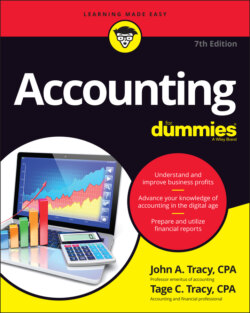Читать книгу Accounting For Dummies - John A. Tracy - Страница 36
Offering a few preliminary comments about financial statements
ОглавлениеRealistic examples are needed to illustrate and explain financial statements. But this presents a slight problem. The information content of a business’s financial statements depends on whether it sells products, services, or both (for instance, Apple sells both products and services); invests in other businesses; and so on. For example, the financial statements of a movie theater chain are different from those of a bank, which are different from those of an airline, which are different from an automobile manufacturer’s, which are different from — well, you name it.
The classic example used to illustrate financial statements involves a business that sells both products and services, and sells on credit to its customers. Therefore, the assets in the example include receivables from the business’s sales on credit and inventory of products it has purchased or manufactured that are awaiting future sale. Keep in mind, however, that many businesses that sell products do not sell on credit to their customers. Many retail businesses sell only for cash (or accept credit or debit cards that are near cash). Such businesses do not have a receivables asset.
The financial statements of a business do not present a “history” of the business. Financial statements are, to a large extent, limited to the recent profit performance and financial condition of the business. A business may add some historical discussion and charts that aren’t strictly required by financial reporting standards. (Public corporations that have their ownership shares and debt traded in open markets are subject to various disclosure requirements under federal law, including certain historical information.)
The illustrative financial statements that follow in this part and Part 2 do not include a historical narrative of the business. Nevertheless, whenever you see financial statements, we encourage you to think about the history of the business. To help you out in this regard, here are some particulars about the business example we use in this chapter:
It sells products and services to other businesses (not on the retail level).
It sells on credit, and its customers take approximately a month or so before they pay.
It holds a fairly large stock of products awaiting sale.
It owns a wide variety of long-term operating assets that have useful lives from 3 to 30 years or longer (building, machines, tools, computers, office furniture, goodwill, intellectual property, and so on).
It has been in business for many years and has made a profit most years.
It borrows money for part of the total assets it needs.
It’s organized as a corporation and pays federal and state income taxes on its annual taxable income.
It has never been in bankruptcy and is not facing any immediate financial difficulties.
The following sections present the company’s annual income statement for the year just ended, its balance sheet at the end of the year, and its statement of cash flows for the year.
